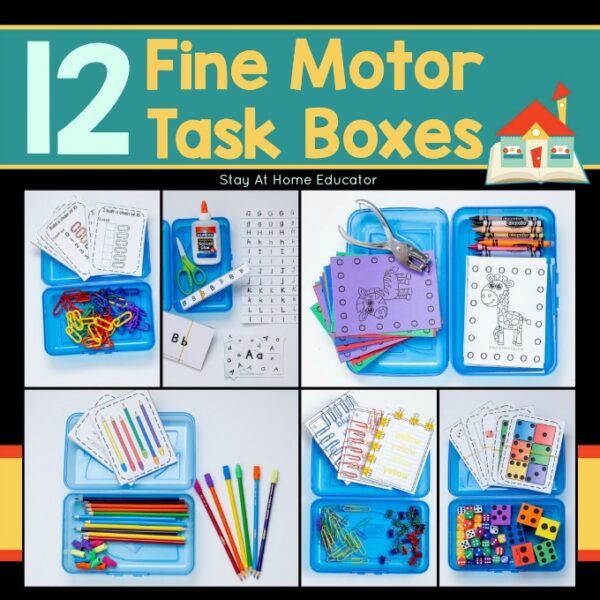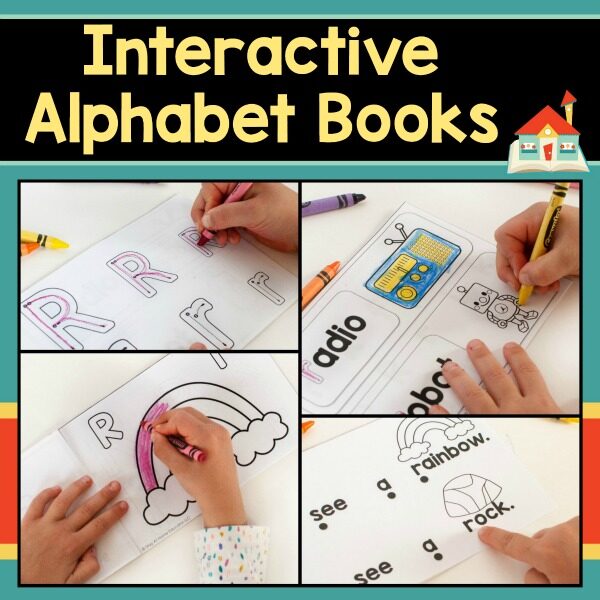Welcome to your ultimate guide to writing development in preschool. We have included everything you need to know about how preschoolers develop writing skills, as well as how to ready your early learners to be successful and confident writers, no matter their writing stage.
With this guide, you will come away feeling confident and with new fun ways to teach writing in preschool.
What You Need to Know About Writing Development in Preschool
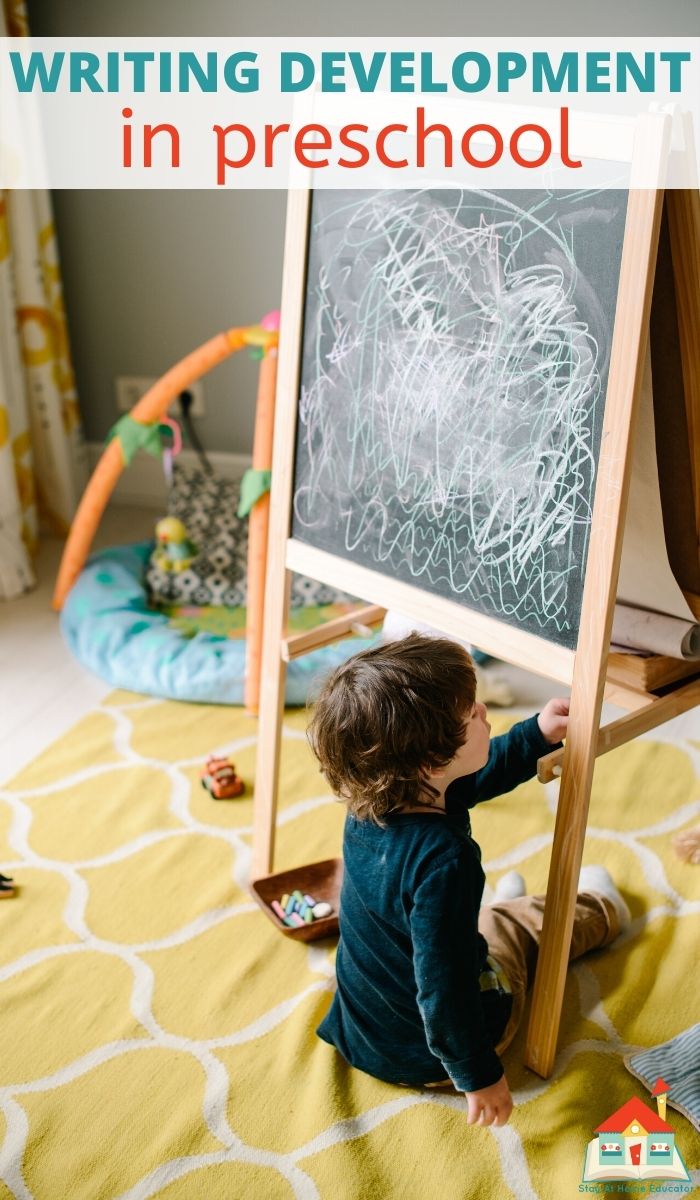
Early writing is critical for the foundation of your preschooler’s future literacy and their overall mastery of language. As early as two years old, children may begin to “write” on paper to express their feelings and attempt to communicate through writing.
True mastery of language comes not only in being able to communicate through speech but in written form as well. When young children begin to express themselves easily is the perfect time to encourage emergent writing.
Emergent writing introduces things specific to written language, which will be unfamiliar at first. Teaching emergent writing encompasses teaching the physical act of creating symbols and teaching that symbols (not just pictures) have meaning attached to them. It also includes teaching the mechanics of written language, such as the knowledge that we read and write right to left, the names and sounds of the alphabet, etc.
Preschoolers will show their writing abilities in various ways such as scribbling, drawing, and
making letter-like forms. Writing is a complex and difficult skill that requires a lot of practice and patience, not to mention strong fine motor skills and hand strength. Simply put, your preschooler needs frequent and daily practice with writing.

The Importance of Writing Development in Preschool
Early writing is one of the best predictors of children’s later reading success (National Early Literacy Panel [NELP], 2008). Specifically, early writing is part of a set of important foundational literacy skills that serve as necessary precursors to conventional reading (Whitehurst & Lonigan, 1998), including developing understandings of both print (i.e., print concept and alphabet knowledge) and sound (i.e., phonological awareness).
https://www.readingrockets.org/article/how-do-i-write-scaffolding-preschoolers-early-writing-skills
How Do Children Develop Writing in Preschool?
Young children go through many stages of writing development on their journey. For a detailed list of what to expect in each stage, check out the ultimate guide to the development of emergent writing.
Exposure to writing in the world around them, including teacher and parent modeling, is a great way to develop writing and confidence in preschool. You can see how emergent writing develops as the child becomes more confident and more versed in the alphabetic principle.
A Symbol of a Symbol
Speech is represented by certain sounds, which are written with letters. Words made with sounds represent objects, people, and ideas. Written words are the visual representation of the oral and aural. They are symbols of symbols.
At first, there is no distinction in the mind of a young child or preschooler between drawing and writing. Their first attempts at written words might be a confusing mess of scribbles, but it means they’re grasping the understanding that writing is a different kind of symbol than an illustration.

The Alphabetic Principle in Preschool Writing Development
An important concept for children to learn is the alphabetic principle, which is “the understanding that oral language is made up of smaller sounds, and that letters represent those sounds in a systematic way.” –Reading Rockets
Preschoolers will replicate letters found in their name as well as other conventional letters and numbers common in their environment. They’ll copy what they see the most. These and other random, letter-like symbols used in their writing show that they know words and letters carry meaning, but they still don’t realize that they have sounds attached to them.
That realization is another critical step in the process – the phonetic connection. You’ll see them try to sound out words by their letters, as well as invent creative spellings in trying to write on their own. Their mispronunciations of words and funky, alternate spellings in their own writing are more than humorous, they’re a sign that they understand each letter or combination of letters has specific sounds attached to them.
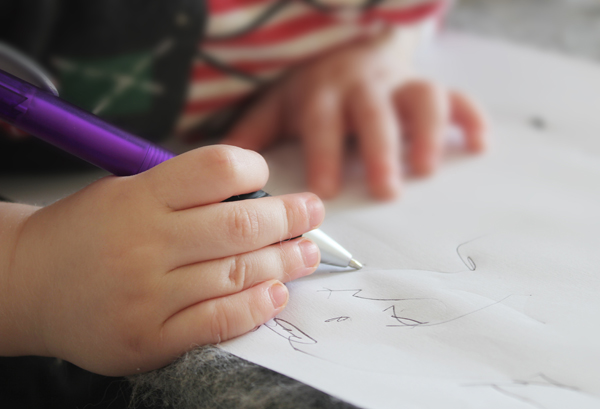
Stages of Writing Development in Preschool
Although there is a typical developmental order of progression in emergent writing, most children don’t completely master a level before moving on to the next. They’ll move to and from and back and forth the levels. Don’t be surprised to see their skills and understanding fluctuate. Moving forward to a more difficult stage or backward to a previous one can sharpen and solidify their fundamentals as a whole.
The typical order progresses as follows:
- Scribbling/drawing
- Letters
- Letter-like forms and shapes
- Letters and spaces
- Conventional writing and spelling
Learning to write is like spending time in a laboratory where children test out combinations of letters and sounds, and ultimately make great discoveries about how sound and print work together. They become literate as they connect the dots between oral and written speech.
As they experiment, give them encouragement. Understand that a lot of their mistakes are great ways for them to learn.
Activities for Teaching Writing to Preschoolers
Writing in preschool comes in many forms and there are lots of ways to include writing practice throughout the day. Having writing materials accessible is the first step to encouraging young writers to take the first step.
Please note: the ways in which we, the adults, respond to a child’s writing in the early stages can do one of two things – it can encourage or smother a child’s desire to write. It is very important that both parents and teachers understand the valuable stages of writing development. This ensures that children only experience a positive and uplifting attitude toward writing.
These are some great ways to get preschoolers involved in daily writing activities that are developmentally appropriate and so engaging:
- Teacher Modeling – Children benefit significantly from teacher modeling. Teachers should regularly model writing and offer opportunities for students to participate in interactive writing.
- Journaling – writing in a journal looks very different when you are in preschool. Journaling in preschool focuses on building fine motor strength, improving hand-eye coordination, and helping young children feel comfortable “writing” in their own way.
- Centers & Dramatic Play – Preschoolers benefit from daily writing experiences, so it is helpful to embed writing in the daily routine. Dramatic play is one of the easiest and best ways to add writing practice in a playful, yet meaningful, way. Check out Play to Learn Preschool for ideas.
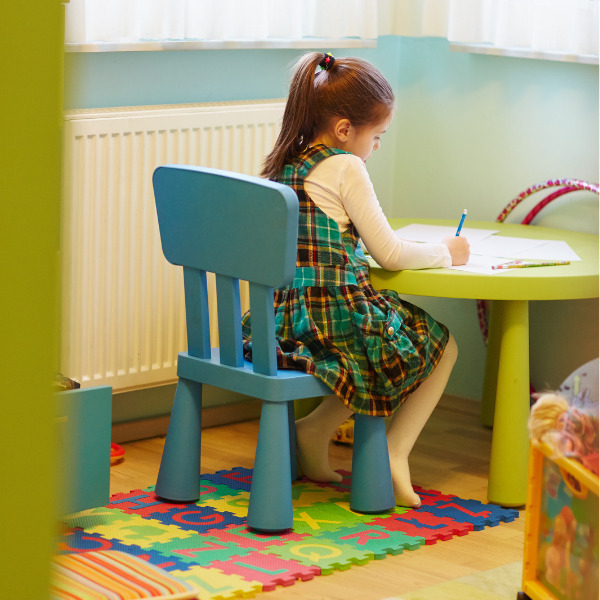
What Writing Development is Not
Emergent writing is not (just) tracing letters and numbers in the preschool writing center. While letter formation and number tracing have their place in the range of writing activities for preschoolers, emergent writing focuses on all the skills preschoolers need to have mastered before tracing and forming the letters has any benefit.
Materials for Writing Development with Preschoolers
Grab some of the best supplies for emergent writing activities with your preschoolers! I have hand-selected my favorite items for writing with little ones.
Tips for Teaching Emergent Writing
- Incorporate writing into play activities. Maybe they’re playing house and could write a grocery list for things they need for dinner, or maybe a villain has left a note for the hero to read. Having a fun purpose behind writing practice can help your preschoolers be excited to learn.
- With your preschooler, write down the sentences they say.
- Ask children to describe their drawings and scribblings to you. This can help them attach meaning to symbols.
- Ask them to identify letters or words they know in a book you read with them.
- Teach them to write their name. Name writing activities are a personal and important way to get children interested in writing and recognizing their own names.
- Make lists of words with your child that start with the same sound, or teach them to listen for the ends of words by having them identify rhyme in a book or story you’re reading.
- Connect letters they write a lot of to new letters you’re trying to teach by connecting those letters to things they know. If you see a lot of B’s in their writing, connect it to the first letter in the name of a sibling or friend. This will help them understand the letter’s sound and application. If you’re trying to teach them the letter D and they get excited every time the neighbor’s puppy meander through your yard, try connecting D with dog.
- Have your child think out loud as they struggle through writing a word correctly. By knowing their thought process and by hearing them struggle through writing a word or phrase you’ll know how to help them.
Free Printable Preschool Writing Activities

I’m Sarah, an educator turned stay-at-home-mama of five! I’m the owner and creator of Stay At Home Educator, a website about intentional teaching and purposeful learning in the early childhood years. I’ve taught a range of levels, from preschool to college and a little bit of everything in between. Right now my focus is teaching my children and running a preschool from my home. Credentials include: Bachelors in Art, Masters in Curriculum and Instruction.

